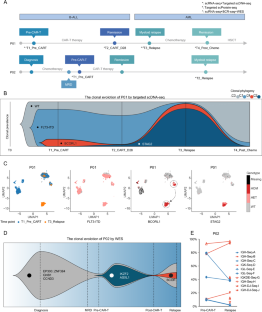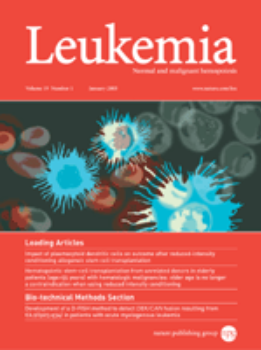The dynamic evolution of lineage switch under CD19 CAR-T treatment in non-KMT2A rearranged B-ALL patients
Shaowei Qiu, Yihan Mei, Runxia Gu, Yu Liu, Manling Chen, Haiyan Xing, Kejing Tang, Zheng Tian, Qing Rao, Donglin Yang, Aiming Pang, Shuning Wei, Yujiao Jia, Huijun Wang, Sizhou Feng, Hui Wei, Ping Zhu, Min Wang, Ying Wang, Wenbing Liu, Jianxiang Wang
求助PDF
{"title":"The dynamic evolution of lineage switch under CD19 CAR-T treatment in non-KMT2A rearranged B-ALL patients","authors":"Shaowei Qiu, Yihan Mei, Runxia Gu, Yu Liu, Manling Chen, Haiyan Xing, Kejing Tang, Zheng Tian, Qing Rao, Donglin Yang, Aiming Pang, Shuning Wei, Yujiao Jia, Huijun Wang, Sizhou Feng, Hui Wei, Ping Zhu, Min Wang, Ying Wang, Wenbing Liu, Jianxiang Wang","doi":"10.1038/s41375-024-02449-7","DOIUrl":null,"url":null,"abstract":"","PeriodicalId":18109,"journal":{"name":"Leukemia","volume":"39 1","pages":"238-242"},"PeriodicalIF":12.8000,"publicationDate":"2024-10-31","publicationTypes":"Journal Article","fieldsOfStudy":null,"isOpenAccess":false,"openAccessPdf":"","citationCount":"0","resultStr":null,"platform":"Semanticscholar","paperid":null,"PeriodicalName":"Leukemia","FirstCategoryId":"3","ListUrlMain":"https://www.nature.com/articles/s41375-024-02449-7","RegionNum":1,"RegionCategory":"医学","ArticlePicture":[],"TitleCN":null,"AbstractTextCN":null,"PMCID":null,"EPubDate":"","PubModel":"","JCR":"Q1","JCRName":"HEMATOLOGY","Score":null,"Total":0}
引用次数: 0
引用
批量引用
非 KMT2A 重排 B-ALL 患者在 CD19 CAR-T 治疗下的系谱转换动态演变
重建克隆进化范式有助于我们理解世系转换的过程[6]。因此,我们通过单细胞靶向DNA测序描绘了患者1(P01)的克隆进化模式(补充表3)。通过单细胞基因组测序和质量控制,我们在四个时间点共获得了 6566 个具有相关基因突变(FLT3、BCORL1 和 STAG2)的高质量细胞,用于克隆结构推断(图 1B,补充表 4)。Tapestri insights 分析(图 1B)显示,FLT3-ITD 突变在四个不同的时间点持续存在(83.3%、69.4%、98.8%、9.0%)。在骨髓复发开始后,原有的 BCORL1 突变迅速扩大,而 STAG2 突变与 BCORL1 突变同时出现(16.1%、4.3%、96.1%、0.0%)。与 T1_Pre_CART 时间点相比,我们发现 BCORL1 突变负荷(图 1C)在 T3_Relapse 时间点有所增加。此外,单细胞膜蛋白数据(补充图1A-D,补充表5)显示,在T1_Pre_CART时间点,B-ALL爆破细胞表达典型的B-ALL相关标志物CD19和CD10,并同时表达髓系相关标志物CD33和CD123,而在复发时,爆破细胞失去了淋巴标志物CD19的表达,证实了系的转换现象。此外,通过全外显子测序和靶向测序重建了患者2(P02)的克隆进化结构(图1D,补充表6)。在P02的整个治疗过程中,融合基因EP300::ZNF384持续表达,IKZF2突变克隆在CD19 CAR-T治疗后消失,BCOR基因突变克隆在髓系复发后出现。通过 BCR 测序,我们观察到在 T2_Relapse 时间点存在与 T1_Pre_CART 时间点相同的免疫球蛋白序列(图 1E,补充表 7),而且我们还观察到在复发过程中免疫球蛋白序列的克隆频率增加,这表明它们在髓系重编程过程中富集。这一结果表明,髓系祖细胞的起源是从 B-ALL 细胞重编程而来[7]。
本文章由计算机程序翻译,如有差异,请以英文原文为准。




